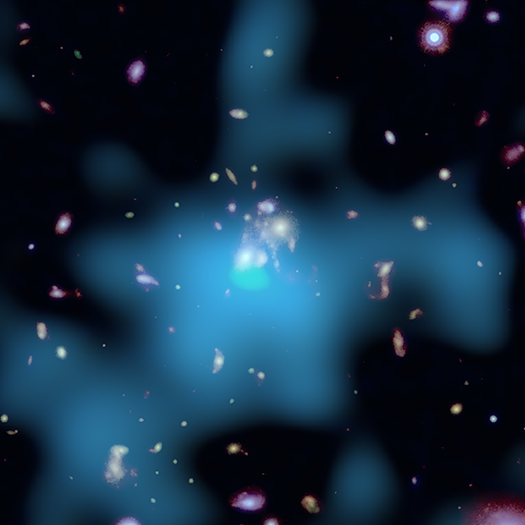History of SpARCS1049

Carter Rhea
We welcome Carter Rhea as our guest blogger and a co-author of a paper that is the subject of our latest press release. Carter completed his undergraduate degree in astronomy at the College of Charleston in Charleston South Carolina. Afterwards, he obtained a master’s degree in scientific computing and computational mechanics at Duke University. Instead of continuing with a PhD, he decided to return to astronomy. He just finished his master’s degree at l’Université de Montréal and will be continuing his Ph.D. there.
Galaxy clusters are an exceptional class of object – they are the largest structures in the Universe held together by gravity, and contain hundreds or thousands of individual galaxies, unseen dark matter, and a vast amount of hot gas that gives off X-rays.
In 2015, a team of astronomers led by Tracy Webb at McGill University in Montréal released the first study of SpARCS1049, which was quickly recognized as an exceptional member of this exceptional class. The team’s optical, infrared, and ultraviolet observations of this galaxy cluster revealed a complex structure of clumpy, cool emission regions forming a tail that trails away from the cluster’s central galaxy. As a reminder, galaxy clusters are the largest structures in the Universe held together by gravity. They are made up of three main things: hundreds or thousands of individual galaxies, unseen dark matter, and a vast amount of hot gas that gives off X-rays.
These regions, also known as “tidal tails,” are usually the remnants of a smaller galaxy that has merged with the central galaxy. Studying the near-infrared images revealed a truly surprising fact: the region around the central galaxy was forming stars at a prodigious rate of nearly 900 solar masses per year! (For comparison, our own galaxy -- the Milky Way -- is creating stars at a pedestrian rate of 3 solar masses per year.)
Follow-up observations of the molecular gas in the system with the Large Millimeter Telescope revealed a massive reservoir; unfortunately, the spatial resolution of the telescope did not allow astronomers to pinpoint the location of the star formation. At this point, the mechanism behind the mysteriously high rate of star formation remained unknown.
Astronomers considered three principal possibilities for what caused this rapid star formation: 1) a major merger between two galaxy clusters, 2) a minor merger (or a series of minor mergers) between the cluster’s central galaxy and other smaller galaxies belonging to the cluster, or 3) a mass “cooling flow” where superheated gas that pervades a cluster cools off enough to allow stars to form.
While the extragalactic astronomy community has yet to develop a complete and coherent scheme of galactic evolution, its efforts have resulted in tremendous strides forward in our understanding of the universe. According to contemporary models, initial star formation (that is, the first round of stellar birth) in galactic centers is monopolized by major mergers between galaxy clusters and large-scale cooling flows of gas.
The study of these monstrous cooling flows has led to an abundance of literature in which the authors explore the cooling flows' role in galactic evolution and the stellar formation rate history of the host galaxy cluster. After sustaining sufficient radiative losses (meaning, enough heat has left the system via radiation), the extremely hot inter-cluster medium -- composed of gas and dust residing at the heart of the cluster's dark matter halo -- succumbs to its own gravitational forces and triggers a mass cooling-flow. The flow of cool, dense gas acts as the ideal nursery for the birth of stars, evidenced by the stellar formation rates of up to several hundred solar masses per year. However, these prodigious levels of star formation are rarely observed and have never been seen in a young galaxy cluster… until now.
Unable to determine the mechanism for the elevated stellar formation rate in SpARCS1049, the team turned to radio wavelengths to study the feeding habits of the supermassive black hole at the heart of the central galaxy. These observations, taken with the NSF’s Karl Jansky Very Large Array in New Mexico, revealed a conspicuous lack of radio emission. In fact, the only notable emission came from the supermassive black hole itself, but even this was extremely weak, leading the team to conclude that the black hole was being starved for gas! At this point, the likelihood of a series of small mergers seemed unlikely. Additionally, in systems with a large-scale cooling flow at the center of the cluster, the supermassive black hole is expected to be more active since it has more sustenance (from the cooling flow).
Next, a team led by Julie Hlavacek-Larrondo from l’Université de Montréal, in collaboration with Tracy Webb’s group, obtained 50 hours (an insane amount of time) of observations on the Chandra X-ray Observatory! The data analysis, spearheaded by myself, a master’s student supervised by Dr. Hlavacek-Larrondo, revealed a significant amount of hot, X-ray emitting gas centered approximately 50 kpc (or about 160,000 light years) from the central galaxy. Further analysis demonstrated the existence of a massive cooling flow within the gas. Since the cooling flow is located a significant distance from the central galaxy and its supermassive black hole, it is not subject to the energy injection normally associated with these systems. Outbursts powered by supermassive black holes usually prevent the hot gas from significant cooling and aggressively arrest star formation.
Because SpARCS1049 is the most distant galaxy cluster ever studied to this degree, we are unsure if it is archetypal of other clusters at this epoch or if it is some sort of outlier; however, if it does represent what’s common in the distant Universe, these results suggest that large scale cooling flows are a viable mechanism for the buildup of stellar mass in the cluster up to much later epochs than previously believed. Cooling flows were expected to only be dominant at times when the universe was less than a billion years old, rather than the age of about four billion years when SpARCS1049 is being observed. In any case, SpARCS1049 is the poster child for clusters in which the central galaxy’s supermassive black hole fails to regulate its environment.
Category:
- Log in to post comments

